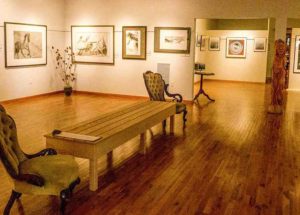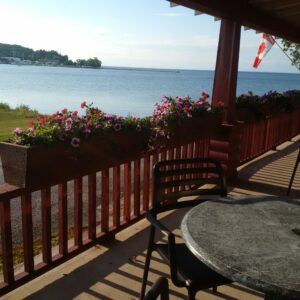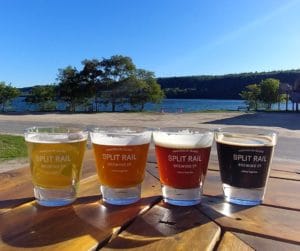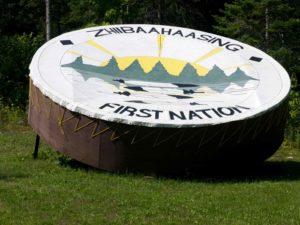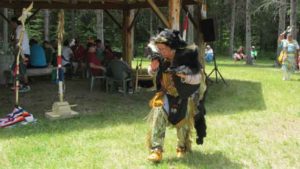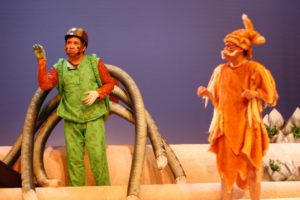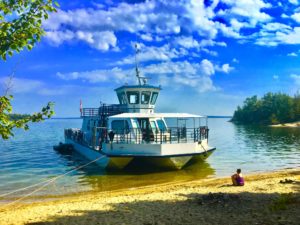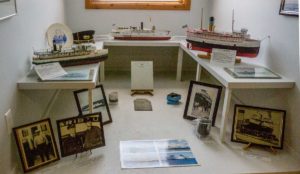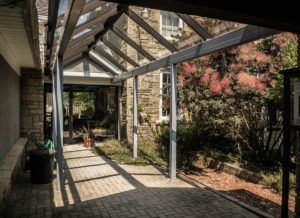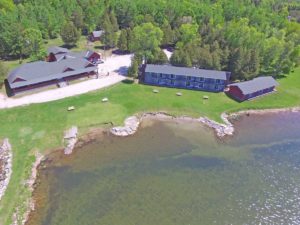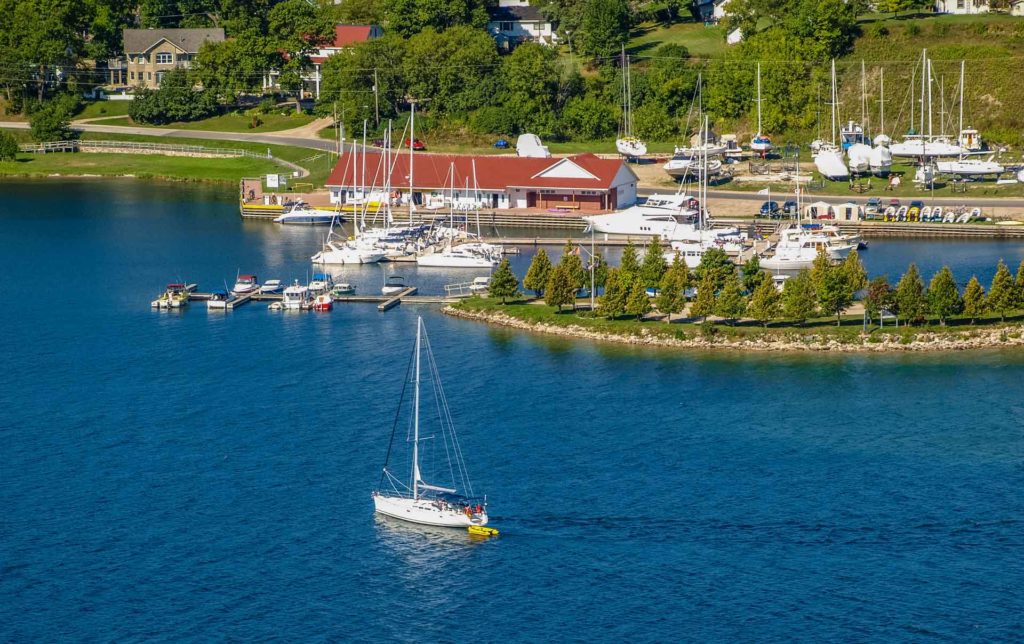Explore
Gore Bay
Points of Interest
An interesting stroll through and across the very bottom of Gore Bay. The interesting boardwalk leaves from Smith Park (an open field waterfront recreation area) adjacent to a basketball court/skateboard park. Walk the other way and you’ll find the tennis courts.
Begins at Bay and Water streets intersection, climbs the scenic East Bluff to park lookout.
Up on the East Bluff, this park and picnic area offers a panoramic view of the harbour and surrounding countryside.
At west end of waterfront. The Harbour Centre Gallery is occupied by many local artisans whose work if for sale in their shops. William Purvis Marine Museum upstairs.
Gore Bay is a special place on Manitoulin. First of all, it is Manitoulin Island’s ‘District Town’ and so the official trapping association with a local ‘capital’ are located here: the Manitoulin District Courthouse, Registry Office, Sherriff’s Office and so on. Gore Bay won a Manitoulin Island referendum to become the District Town in the 1880s. The Island had been sufficiently settled by then, following the Manitoulin Treaty of 1862 that the Ontario government decided it should be its own jurisdiction and no longer be attached to Algoma.
Gore Bay put in a bid, as did Manitowaning and Little Current. The two east-end Island communities split the vote in that area while Western Manitoulin solidly backed Gore Bay and hence the imposing limestone courthouse was built high above the main street and beyond that, its waterfront.
The district jail was also built at this time as a part pf this complex and, when it fell into disuse a half-century ago, the municipality acted quickly to secure the historic building as the town’s museum.
It still is that but the energy of the museum’s curator and its board were able to secure funds to add on wonderful airy gallery space in which a number of talented, almost exclusively Manitoulin, artists are showcased through the summer months each year.
The municipality owned a fairly new and spacious waterfront building, alternatively faced with wood, built to be an “incubator building” in the 1980s, providing space to encourage new business industries to locate in Gore Bay.
A series of start-ups moved in and out of the building, but it was deemed to be largely underused, at least for its original purpose.
And then the same fertile minds that had created gallery space at the Gore Bay-Western Manitoulin Museum took an interest and, within a few years, the Harbour Centre was born.
It’s now woven of small studio spaces and arts retail spaces, open all year, that has added much to the intended eventual recognition of the town as an arts hub.
The upstairs of the building houses the William Purvis Marine Museum, dedicated to the fascinating lore surrounding Gore Bay’s, and Manitoulin’s place in history of Great Lakes commercial shipping. This museum is named after the dynastic commercial fishing business, one of the largest on Lake Huron, that was established in 1882 and is still run by the decedents of William Purvis.
In the Gore Bay area:
Watersedge Pub & Restaurant
Gore Bay Manitoulin Hotel
Split Rail Brewery
Zhiibaahaasing First Nation Traditional Powwow
Sheshegwaning First Nation Traditional Powwow
Theatre
Golf
Canadian Yacht Charters
North Channel Cruise Lines
Purvis Marine Museum
Gore Bay Museum
Noble Nature Trail
Sheshegwaning – Nimkee’s Hiking Trail
Misery Bay
Gore Bay Boardwalk Trail
Codmothers
North Channel
Lake Wolsey
Ice Lake
The Inn at Gore Bay
On Manitoulin Island, any reference to Gore Bay often has an associated reference to Manitoulin Transport or, more properly, The Manitoulin Transport Group of Companies.
This giant in Canadian commercial transportation has not only its roots but continues to have its head office in the town in which its founder, Doug Smith, grew up and where, in fact he continues to live as he has done all his life.
Manitoulin Transport is Canada’s most extensive transportation network and, for Gore Bay it is the industry that every small-town dream of having as a source, not only for local jobs, but for local pride.
The Manitoulin Transport head office is located on the main entry to town off Highway 540 and the large parking lot, usually filled with cars day and night, attests to the local importance of this national business.
The town’s main street, Meredith Street, is a typical small-town front street as it represents the community centre of commerce. In Gore Bay, these are hardly any outliners: everybody conducts their business downtown.
Of particular interest is the town’s Community Hall, stone-built in the early 1930s and standing proudly on the north side of the business district. It’s a busy place all year but in July, it is transformed into the home of the Gore Bay Theatre where an award-winning cast, overseen by award-winning directors (everyone is from somewhere near Gore Bay) will entertain you with two offerings through July each year.
And then, there is the waterfront. Unlike Little Current, Kagawong and Meldrum Bay, other North Channel port towns, Gore Bay’s downtown front street didn’t evolve right on the harbour. This decision gave Gore Bay the opportunity to develop business street with building on each side of the thoroughfare, unlike the other towns whose downtown businesses face the waterfront.
In Gore Bay’s case, there is another street, with the business street, that follows the lakeshore.
At its west end sits the aforementioned Harbour Centre and William Purvis Marine Museum as a waterfront institution.
Right across the street is the town’s craft brewery, Split Rail Brewery, with opportunities for retail sales and samplings of the locally brewed products.
There is a seasonal restaurant nearby, a waterfront parkette supported by the local Rotary Club and then the town’s expansive marina and long white marina service building which is also the home of Canadian Yacht Charters (CYC) a (mostly) sailboat leasing business.
There are boaters’ facilities, lots of parkland along this street, a very old hotel, the Queen’s Inn, which has been restored and repurposed as a bed and breakfast facility.
Back on the water side, the town’s tennis courts are there as is the iconic Red Roof Pavilion: a tall, wide round building topped with, naturally, a red roof. There is a unique seasonal restaurant on the second floor, high above the boats and harbour.
The local Lions Club’s children’s waterfront playground sits beside the pavilion’s parking lot and, just a little further on, past more parkland that houses outdoor basketball courts will soon be home to an elaborate splash pad for children, the town’s boardwalk begins.
It crosses more waterfront parkland a marshy area at the very foot of Gore Bay and ends at the grounds of The Inn at Gore Bay, (waterfront accommodation,) and Live Edge, its associated restaurant.
Gore Bay sports a hiking trail too: The Noble Trail which is also accessible from this end of the boardwalk.
It winds its way up the East Bluff, another of Gore Bay’s defining natural features, and gives hiking access to the Harold Noble Memorial Park, a Lions Club initiative, that offers a spectacular view not only of the town laid out panoramically across the water but of the whole water feature, also called Gore Bay, and its long fetch in from the North Channel.
This lookout, and another one further along, are also accessible by mother vehicle or bike from a well-marked street that exits from the town’s easterly entry road.
Just one kilometer south of that Gore Bay’s entry road off Highway 540 is the Manitoulin Island Country Club, a well-established 9-hole golf course complete with a licenced dining area, club and gold cart rentals. It’s a very pleasant course.
About 10 kilometers west of Gore Bay, Highway 540 B leads off the main highway (the main route takes a 90 degree turn at this intersection; the 540 B option is straight ahead) and leads to the Gore Bay-Manitoulin Airport. This is a year around facility. The runway is lit and mist aviator fuels are available here.
Gore Bay’s annual ‘Big Days’ are the July weekend names Gore Bay Harbour Days. They involve all of the town’s service clubs and success of this fun weekend.

